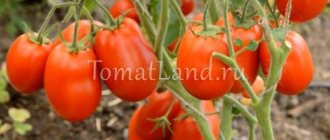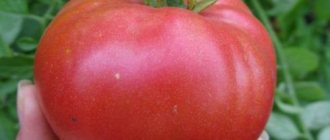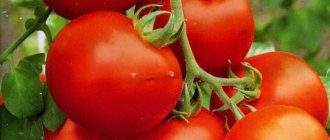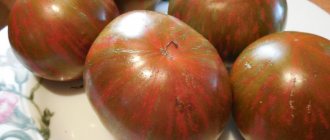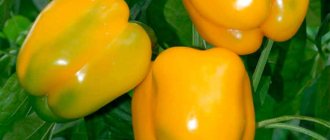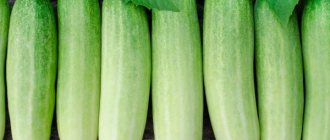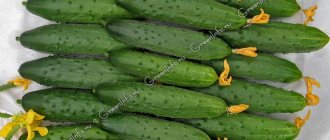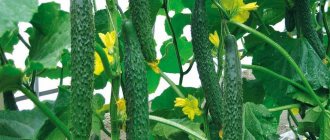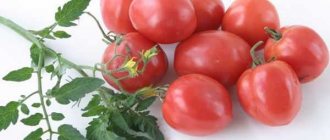Among varieties intended for cultivation in cold climates, the Alaska tomato stands out for its relatively short ripening time and resistance to most diseases characteristic of this crop. Based on its set of characteristics, it is considered one of the best early-ripening tomatoes intended for cultivation in extreme farming zones. Next will be reviews, photos and descriptions of the Alaska tomato variety.
Characteristics and description of the Alaska tomato variety
The Alaska tomato is an early-ripening, determinate and fairly productive variety, intended for cultivation in temperate and cold climates. It is equally suitable for greenhouses and open ground. The variety has proven itself well for regions with short and relatively cold summers.
The ripening time of a tomato is up to 80 to 100 days, depending on the chosen growing method. An important characteristic of a tomato is its low growth. The average height of the bush ranges from 50 to 60 cm. Thanks to this, the tomato can thrive in difficult weather conditions.
Low bushes require virtually no care, but it is recommended to carry out at least minimal plant formation to ensure greater productivity.
Fruit characteristics
As for the most undersized variety, Alaska's yield is good. Getting 2 kg per bush even in cold summer is just an excellent indicator.
One plant produces a large number of tomatoes. As a rule, the brushes go through 1-2 leaves. Each contains 3-4 fruits weighing 100 g.
One of the important characteristics of Alaska tomatoes is that they quickly gain color and sweetness. Therefore, 80 days are enough for full ripening.
Tomatoes of this variety grow very tasty and sweet. They have a moderately thick skin, so the fruits can be used for canning. Tomatoes also tolerate long-term transportation well. You can store tomatoes in a cool place for several months, but for this it is better to pick them when they are a little greenish.
Pros and cons of the Alaska tomato variety
Tomato Alaska has the following advantages:
- excellent taste and versatility of use;
- The height of the bush is up to 60 cm, which greatly facilitates the care of the plant (in particular, there is no need for tying);
- pinching a tomato is optional;
- the bush forms almost independently;
- growing seedlings and forming fruits can be carried out even in cold conditions;
- the plant is resistant to fusarium;
- the fruits are the same size and do not crack;
- good keeping quality (up to 2 months without fading);
The disadvantages of the Alaska tomato include:
- poor transportability;
- When stored for a long time, the taste of tomatoes deteriorates.
Based on the combination of positive and negative properties, the Alaska tomato can be called very successful.
Advantages and disadvantages of the variety
Caring for Alaska tomato bushes is simple due to the low growth of the crop. Resistance to viruses will allow you not to spend a lot of time on processing and protecting plants.
It is possible to grow seedlings even in cold climates
pros
- the fruits have a rich taste and are universal in use;
- independent formation of a plant;
- resistance of the variety to major tomato diseases;
- uniform size and density of fruits;
- keeping quality of tomatoes.
Minuses
- deterioration in the taste of fruits during long-term storage.
Optimal growing conditions
Growing conditions for Alaska tomatoes are standard for any similar crop. It is advisable to place the bushes in sunny areas with partial shade at midday. For this purpose, it is recommended to use nets or shields.
Watering should be regular, without excessively moistening the root zone. Like all tomatoes, Alaska does not like areas exposed to the wind.
About the variety
The variety is early ripening (85-100 days) and high-yielding. The fruits begin to ripen at the end of June. "Alaska" is considered determinate, that is, it has limited stem growth. A bush about 0.5 meters high needs tying to a support and moderate pinching. The first inflorescence is formed above the 8-9 leaf, the subsequent ones - every 1-2 leaves. Number of nests – 3-4. No molding is required when growing. The yield of the variety is 2 kg per bush (with proper agricultural technology).
Growing
Both seedling and non-seedling cultivation of the crop is allowed. One method or another is used depending on climatic conditions. If the weather permits, the seeds can be planted directly in open ground or a greenhouse, provided that the temperature is not lower than + 15 ° C. For most northern regions, such conditions in the spring are unlikely, so they use the cultivation of Alaska tomatoes through seedlings.
Growing seedlings
Planting dates for seedling cultivation should take into account the characteristics of the area. Agrotechnical measures must be planned in such a way that young plants are planted in open ground at a temperature of + 18-20 ° C.
The period of seedling cultivation of Alaska tomato takes 40-45 days. Usually, by the first days of May, the temperature in the greenhouses will have already reached an acceptable temperature for transplantation. In open ground, similar conditions occur in about a month.
Thus, planting seedlings with further greenhouse cultivation is carried out in mid-March, with cultivation in open ground - in mid-April.
Before planting, the seeds must be treated with a 0.1% solution of potassium permanganate and a growth stimulator. Next, it is recommended to dry them and soak them again for 1-2 hours in warm water for preliminary germination.
Planting is carried out in seedling boxes or separate pots filled with ordinary soil or peat substrate. Its composition is standard - mix in equal proportions:
- peat,
- sand;
- garden soil.
It is recommended to disinfect the substrate before planting in any convenient way: either thermal or chemical using the same potassium permanganate. The depth of Alaska tomato seeds when planting is 10 mm.
After this, the seedlings are covered with film and sent to a warm place (+ 20-23 ° C) until the first shoots hatch. After about a week, as soon as the first shoots appear, the box with seedlings is moved closer to one of the sunny windows. In this case, it is recommended to slightly reduce the room temperature (to + 15-18 °C).
Watering is carried out weekly using a spray bottle. It is necessary to moisturize the seedlings in combination with 2-3 fertilizing with complex fertilizers, repeated once every 2 weeks.
Picking is carried out as standard - after the appearance of 3 true leaves. After about a month and a half, the seedlings will be ready to be transplanted into a greenhouse or open ground.
Attention! A week before planting, it is necessary to carry out the procedure of hardening the seedlings.
Landing rules
To plant a plant in a permanent place, dig holes up to 15 cm deep, at the bottom of which it is recommended to lay a layer of compost or humus up to 5 cm high.
Planting seedlings in open ground is carried out according to the scheme 50 by 50 cm or 30 by 40 cm. In this case, the number of plants per 1 sq. m should not exceed 4-5 pieces.
Bushes are usually arranged in two rows. Sometimes their arrangement in a checkerboard pattern is allowed.
Watering and fertilizing
Watering an Alaska tomato is no different from watering most tomatoes; it is carried out as needed. Typically, the criterion for watering is the drying of the top layer of soil.
Watering rates are 5 liters per bush. They are carried out in the evening or in cloudy weather. To do this, use water several degrees warmer than the air temperature. It is advisable to use tap water that has been left standing for 1-2 days.
Warning! Sprinkling is not recommended for Alaska tomatoes.
Pinching and tying
The varietal peculiarity of Alaska is such that the bush does not need tying or pinching at all. To achieve the required yield indicators, it is recommended to still adhere to relatively simple rules:
- The garter is attached to the support in two places: at a height of 40 and 60 cm.
- Apply partial stepson:
- lay the first inflorescence on the 8th or 9th leaf;
- laying of subsequent inflorescences - through one or two leaves.
The plant should be planted carefully, without getting too carried away with the process (the procedure is still considered partial). Otherwise, it can lead to weakening of the entire bush.
Formation
As noted earlier, the formation of a bush is carried out in one stem. At the same time, the most promising branches that are capable of producing good yields are left on the plant.
Important! If the plantings are too dense, you need to remove the lower leaves on the tomato bushes in time. Thanks to this, the plants will receive more air and light, in addition, the root zone will be freed up for better gas exchange.
Protection from diseases and pests
The Alaska tomato has high resistance to diseases, in particular, tobacco mosaic virus and fusarium. In general, the culture in question resists many diseases quite well.
To prevent common diseases such as powdery mildew, it is recommended to use standard treatment methods. If characteristic symptoms of fungal diseases appear, treatment is used in the form of spraying with preparations containing copper. This can be a 1% solution of Bordeaux mixture. Treatment is carried out once every 12-15 days.
Pests are also standard for all nightshade crops - these are Colorado potato beetles and wireworms. Any insecticide of medium activity is used against them, for example, Decis.
Important! When transplanting plants into open ground, it is recommended to treat the bushes with Decis or Arrivo as a preventive measure.
General information
Alaska is a variety with a fast fruit ripening period, which is only 80 - 100 days after sowing the seeds for seedlings. The first tomatoes will ripen in June. But every gardener looks forward to an early harvest! And how pleasant it is to pick the first grown fruit!
The growth of the stems of these tomatoes is limited. The height of the bushes reaches only half a meter. So the name “dwarf tomato” is quite appropriate. It is the short stature that makes the bushes easily tolerate low temperatures.
Alaska is the only low-growing variety that requires tying up branches and forming bushes. However, you shouldn’t get too carried away with removing stepchildren, because the plant may get sick. Usually, gardeners leave every second stepson. Only those stems that bend to the ground under the weight of the fruit need to be tied.
Tomato Olesya: variety description, photos, reviews
The Olesya tomato, unpretentious and cold-resistant, was bred by breeders from Novosibirsk. The variety has been included in the State Register since 2007 with recommendations for cultivation in all regions, both in greenhouses and in open ground. Orange fruits of medium and large size are very tasty and suitable for harvesting.
Characteristics and description of the tomato variety Olesya
The tomato plant of the Olesya variety is of an indeterminate type, and can, in favorable conditions, rise up to 2 m. In August, the tops of the stems are pinched so that the tomatoes can be successfully poured from the last bunch and have time to ripen before frost. The tall bush usually reaches 1.5-1.7 m and produces many stepsons.
The stems of the Olesya tomato, according to reviews and photos of those who planted it, are strong and can withstand a bountiful harvest of fruit. The leaves are of the usual shape for tomatoes, dark green, rather large. Simple inflorescences are formed, like most indeterminate tomatoes, after 9-11 true leaves.
Next, fruit clusters are formed through 3 leaves.
Producers of the variety indicate that a late tomato will ripen 116-120 days after emergence.
Attention! Caring for Olesya tomatoes includes mandatory pinching and staking of stems so that they develop vertically.
The Olesya tomato variety, judging by reviews and photos, produces large fruits, especially if it is grown in a greenhouse. The fruit sizes are from 6-8 cm in length and 4-6 cm in diameter, weighing 155-310 g. In open ground, Olesya tomatoes are smaller, but more ovaries are laid. Weight from 90 to 270 g, average weight - 130 g. The fruits are oval-shaped, similar to plum-shaped ones, but more rounded.
The skin and pulp are intense orange when fully ripe. According to some reviews, the skin is very thin and bursts during canning. Although other housewives insist that the tomato remains intact.
The structure of the pulp is tender, fleshy and dense, but juicy, there are few seeds. The authors recommend the Olesya variety for fresh consumption. The taste of orange tomato is pleasant, sweet, with balanced acidity.
Tomatoes of the Olesya variety contain 3.4% sugars and 15-16% ascorbic acid.
The excellent taste and aesthetic qualities of orange tomatoes make them indispensable in summer salads and slices. Excess fruits make good raw materials for preparing winter salads. Overripe ones are used in the general mass of red tomatoes for sauces or juice. The fruits last up to 10-14 days.
Important! It is believed that orange tomatoes do not cause allergic reactions.
Late-ripening tomato varieties, which usually have a pleasant sweet taste, like Olesya tomatoes, ripen in August. Only in a heated greenhouse can you start growing tomatoes in April and get a harvest in July.
The authors of the variety indicate an average yield per 1 square meter. m – 6.4 kg. In a greenhouse, each bush produces over 2 kg of tomatoes, in open ground - 1.5-2 kg. In order for the variety to reveal its potential, the plant is formed:
- stepchildren are planted, leaving only the first stepson for the second stem, and the rest are removed;
- lead into one or, more often, into 2 stems;
- tie the stems to the supports;
- in early or mid-August, after tying the upper fruit cluster, pinch the top.
The productivity of indeterminate type tomatoes largely depends on the formation of the plant, but also on the nutritional value of the soil, timely watering, and maintaining humidity in the greenhouse.
Advantages and disadvantages
Attractive Olesya tomatoes, according to the photo and description, are finding more and more lovers of large-fruited and tall vegetables. Over the years of cultivation, gardeners have identified many advantages of orange tomatoes:
- medium sized fruits;
- attractive shape and color;
- pleasant soft taste;
- transportability;
- unpretentiousness to growing conditions.
The disadvantages of the selection form include:
- late ripening;
- susceptibility to fungal diseases;
- average yield;
- indeterminateness, which requires the mandatory formation of the plant.
Warning! According to reviews from gardeners, the size of the fruits of the Olesya variety decreases if the plant is grown into 2 stems.
When caring for Olesya tomatoes, standard agricultural techniques are used.
Aftercare
In open ground, water after 2-3 days if there is no rain. Water is heated in the sun, 1.5-2 liters are poured under each root. In the greenhouse, water every other day, in the furrows between the rows, avoid the sprinkling method, because due to excess dampness, whitefly infection is possible.
It is important to ventilate the room so that the humidity is between 65-75%. After watering, the dried soil is loosened in the first weeks to 10 cm, then superficially - up to 5-6 cm, so as not to damage the roots, and mulched.
9-12 days after planting, the bushes of tall Olesya tomatoes, according to the description and photo, are earthed up after mandatory watering to strengthen the root system, then the procedure is repeated 2 weeks later.
The variety is fed after 16-21 days. Dilute in 10 liters of water:
- 1 tbsp. l. ammonium nitrate;
- 2 tbsp. l. potassium chloride;
- 3 tbsp. l. superphosphate.
This composition is used before mass ovary. Then the fertilizer ratio is changed:
- 2 tbsp. l. superphosphate and ammonium nitrate;
- 3 tbsp. l. potassium chloride.
1 liter of fertilizer is poured under the root. It is more convenient to use complex mineral preparations.
Growing and caring for tomatoes
Despite the good immunity of the Burkovsky early tomato, it is necessary to adhere to the basic advice of experienced gardeners who know a lot about growing healthy and sustainable vegetable crops. Here are general recommendations for planting tomato seeds, growing seedlings, fertilizing and caring for adult plants.
- install a greenhouse where you will grow seedlings. When the soil and air temperature warm up in the greenhouse (greenhouse), it is necessary to prepare the soil. Mandatory measures include: adding nutrients (peat, humus), disinfection (use Fitosporin, Trichodermin). The soil should be loose so that it is easier for the seeds to germinate and take root;
- To increase germination and stability, before placing the seeds in the soil, the planting material is treated with a growth stimulant. Seeds can be soaked in growth stimulator “Athlet”, “Epin-extra”;
- young sprouts are watered only with warm water. Under no circumstances should you water the seedlings with cold water, this will cause the appearance of a black leg or the death of immature tomatoes;
- on the twentieth day after germination, you need to make the first fertilizing, which will allow the plants to gain strength for further sustainable development. As fertilizer you can use “Nitrophoska”, “Gumate”;
- Before planting, seedlings must be hardened off. This measure will allow plants to adapt faster after transplanting into open ground;
- an hour before transplanting seedlings, water the holes abundantly and apply mineral fertilizers;
- adult plants are watered once a week. The garter occurs as the bushes grow; there is no need to pin shoots;
- before the budding process, tomatoes can be sprayed with a growth stimulator or fed with fertilizers;
- be sure to loosen and weed the beds to protect the vegetable crop from weeds that will interfere with the normal development of plants;
- on one square meter, it is recommended to place no more than 5 plants, the “golden mean” is 4 sprouts.
Let the advice you receive allow you to grow strong and healthy plants that will yield a good harvest.
Eco-friendly harvest on the balcony with Alaska tomato: description of the variety and care tips
Tomato Alaska Gavrish is an early variety with a friendly yield. It is grown in all regions. Delicious salad fruits, short growth and endurance of bad weather made it especially popular in the middle zone and Siberia.
| Height | Landing location | Ripening time | Fruit color | Fruit size | Origin | Fruit shape |
| short | Open ground | Ultra early | Reds | Average | Variety | Round |
Description and characteristics of the variety
The variety was developed by Gavrish in 1998. Included in the State Register in 2002. Alaska is recommended for cultivation on private farms and garden plots. It is also grown by small farms that do not have greenhouses; the variety ripens excellently in open ground and under temporary film covers.
The purpose of the variety is salad. The tomato ripens early. The first fruits begin to set at the end of June, the main harvest takes place 90-95 days after the seedlings appear on the soil surface.
The leaves are medium sized, light green in color. Stem with a determinate type of growth. The height of the plant is small - 60-70 cm. The bush has beautiful outlines. The first inflorescence appears above the 8th-9th leaf, the subsequent ones are laid through one leaflet.
The fruits are round, slightly flattened, with smooth sides, bright red in color. The unripe fruit is green in color. Each tomato has 3-4 nests. Fruit weight is about 90 g.
Despite their early maturity, tomatoes have good taste. The fruits quickly gain color and sweetness. The density of the pulp is medium, the taste is sweet and sour. The fruits are suitable for fresh consumption in summer vegetable salads; excess can be processed into juice or lecho.
Advantages and disadvantages
- fruits are leveled;
- not afraid of bad weather;
- resistant to diseases;
- does not need shaping;
- no need to stepchild;
- you don’t have to tie it up;
- no need for treatment with fungicides and insecticides - the harvest will be environmentally friendly;
- peat humus pots or cups are not required - seedlings can be planted directly into open ground or into a cold nursery;
- good size for early ripening tomatoes;
- pronounced taste and smell of ground tomatoes;
- suitable for container growing and balconies;
- the skin does not crack;
- extended fruiting;
- not picky about soil;
- It is convenient to cover low bushes with film or non-woven material in case of frost.
Minuses:
- insufficiently good transportability of fruits;
- deterioration of taste during storage.
Productivity
An average of 2 kg of fruit is obtained from one plant. In open ground, 9-11 kg are collected per square meter. With intensive agricultural technology - spraying with growth stimulants, fertilizing, abundant watering - the yield increases.
Features of cultivation and storage
In regions with a long frost-free period, the variety can be grown without seedlings, sowing the seeds in April-May directly into the ground. In cold climates, seedlings are sown at the end of March, picking is carried out in the first leaf phase. Planting in containers and balcony boxes is possible as early as the end of May.
In open ground, plants are planted according to a 40 by 60 cm pattern. Bushes are grown without shaping.
In very dry summers, tomatoes are watered every 3 days. It is necessary to allow the soil to dry out between waterings. Constantly wet roots are attacked by soil rot, and the plants die.
Planting and care
Seeds must be treated before sowing. Three percent hydrogen peroxide, purchased at any pharmacy, will rid the surface of the seeds of phytopathogens. The seed is simply poured with peroxide for 20 minutes, then washed several times in clean water.
To accelerate germination and give seedlings resistance to adverse conditions, Epin is used. This is a universal anti-stress adaptogen. The Epin ampoule is designed for 2 liters of water. If this volume is large, you can take half an ampoule per liter:
- take 1 ml of the drug with a syringe;
- pour into a liter jar filled with water;
- stir well;
- drop the seeds wrapped in a bandage or gauze.
Exposure time from 2 to 4 hours. Then the seeds are dried until they flow and sown.
Description of the Rocket variety, its characteristics, growing region
Tomato Rocket was created in the 1970s. in Krymsk. The application for registration was submitted in 1975, but for some reason only 5 years later the variety received its place in the State Register of Breeding Achievements. And even there a surprise awaited him: if on the “cover” the Central Black Earth, North Caucasus, Ural and West Siberian regions are listed as growing regions, then in the detailed description we are talking only about the North Caucasus. And this fits well into its history: looking at the set of recommended regions, it is difficult to explain logically: why is the warm Caucasus adjacent to the harsh Urals here? Amateurs decided in their own way and began to grow Rocket everywhere. At the same time, both in greenhouses and in unprotected soil, the variety consistently produces excellent results.
Even about the use of fruits in the official document, the opinion is ambiguous: it is indicated that this is a variety of universal use, but in the classification it is indicated as a canning variety. Indeed, the size and shape of tomatoes allows them to be successfully used for whole-fruit canning. Moreover: the fruits ripen quickly, hang on the bushes for a long time without over-ripening, and are suitable for one-time mechanized harvesting. This is a big plus from the point of view of industrial use of the variety. In amateur vegetable growing, it’s not for everybody: many people like varieties with extended fruiting.
The first fruits may ripen before the rest, but they will hang and wait for their fellows
Rocket is a mid-early tomato: the fruits are harvested 4–4.5 months after emergence. The bush is determinate, of medium height, a little more than half a meter, compact, which allows you to save space in the garden bed. There are few leaves: the fruits are well illuminated by the sun. Each cluster contains from 4 to 6 fruits. The first inflorescence is located above the 5th or 6th leaf, each subsequent one is located after 1 or 2 leaves.
The shape of the tomato corresponds to the name of the variety: elongated plum-shaped, smooth, red. The fruits are medium-sized: from 34 to 58 g. The taste of fresh tomatoes is not considered excellent, assessed by tasters at 3.8–4.0 points. The skin is dense, cracking is not observed in moderate rainy weather. The pulp is fleshy, the fruit contains 2 or 3 seed chambers. Tomatoes are also used in salads, but they are mainly used for all kinds of preparations.
The Rocket should have a slightly drawn-out nose, this is how it looks different from many similar tomatoes
The yield is high: during industrial cultivation, during the main harvest, up to 600 c/ha are removed, after which only a few tomatoes remain, which also ripen over time. In amateur gardening, the yield is about 6.5 kg/m2. The fruits have excellent transportability.
The variety removes a lot of nutrients from the soil, so it requires intensive fertilizing, especially potassium fertilizers. It is weakly affected by diseases.
Landing
Growing seedlings begins with sowing seeds.
For planting, you can use a substrate consisting of peat, sand and soil in a ratio of 2:1:1. For better growth of seedling roots, 25-30 g of superphosphate per 10 liters of substrate is added to the mixture.
Before sowing, to speed up germination, seeds are soaked overnight in 0.02% succinic acid. After this, they are treated for 20 minutes with 1% potassium permanganate, washed, dried until crumbly and sown.
A gram of tomato seeds contains 200-280 pieces. They produce 180-250 full-fledged seedlings. When growing seedlings, it is necessary to provide a 10% safety margin.
Immediately after sowing, the temperature in the room is maintained at 25-30 degrees. With three-day germination on damp cloth or paper, seedlings will appear in 1-2 days, without germination - in 5-7 days. Immediately after the leaves appear on the surface, the temperature is reduced to 16 degrees. After 4-5 days, they increase it to 19-22 degrees and continue cultivation in this mode until planting in the garden.
When the cotyledon leaves on the seedlings are fully expanded (usually this happens 10-12 days after emergence), the seedlings are dropped into prepared pots filled with a nutrient mixture. The day before picking, water the soil generously - this will make it easier to extract the roots from the soil. Weak plants that are lagging in development are discarded.
Seedlings that have reached the age of 55-60 days are planted in the ground. Each hole is filled with a handful of humus and a tablespoon of superphosphate. Immediately after planting, the plants are watered with warm water.
The Altai pink planting scheme is one-line. The distance between plants is 50 cm, row spacing is 70 cm.
Features of cultivation
Seeds for seedlings are sown in any ten days of March. Planted under film in late May-early June. Harvesting occurs from late July to mid-September.
Garter
Already on the second or third day after planting the seedlings in open ground, the stem is tied to a trellis wire. The twine is secured under the first or second leaf, making sure that as the stem grows and thickens, the rope does not cut into the fabric.
Formation
Plants grow in one stem, cutting off all the stepsons and leaving a small stump in place of each. The lower leaves that have served their purpose must be removed. The signal to begin the operation is the yellowing of the leaf plates. No more than two leaves are removed at each time. The stem is exposed only up to 5-6 brushes. At the end of August, the top of the main stem is pinched, allowing all the fruits to ripen.
Reviews from gardeners about the Alaska tomato
- Anyone who has planted Alaska will agree with me that these are simply excellent tomatoes. Very tasty and do not require special cultivation techniques. I recommend this variety to all gardeners who want to get a good and early harvest of tomatoes. (Valentina Dmitrievna, Perm)
- Growing these tomatoes is a pleasure. They tolerate temperature changes well, are suitable for cold climates and ripen earlier than other varieties. They make wonderful salads, but winter preparations are not particularly successful. I conclude that they are suitable for fresh consumption only. (Alexandra, Irkutsk)
- I read good reviews about Alaska, decided to plant it myself and did not regret it. For the first time in my life I was able to grow tomatoes on the balcony! And without any special labor and time costs. I have never been so happy before. (Oleg Sergeevich, Syzran)
See also
Description of the Sasher tomato variety, its characteristics and cultivationRead
- My description of “Alaska” is the most positive. I have never been able to grow tomatoes so easily and quickly. I recommend it to all “lazy” gardeners, since this variety requires the simplest care. And in terms of results, “Alaska” is not inferior to demanding and finicky varieties. (Alina, Moscow)
- I planted the seedlings in April, planted them in the ground in May, and already at the end of June, tomatoes ripened in my garden, excellent in both appearance and taste. I made homemade preparations from them, soon we will try with our family how it turned out. (Olga Vladimirovna, Lipetsk)
- I’ve been growing “Alaska” for three years now. This variety suits me quite well. They say that it is only salad, but I also make lecho and the sauces are different. Probably, it also depends on culinary skills, and I am an experienced cook. (Alexandra Fedorovna, Tver)
- "Alaska" is a wonderful variety. Unpretentious and productive. The taste is sweet and very delicate. The salads they make are simply amazing. All the guests ask what these wonderful tomatoes are. (Olga Viktorovna, Yekaterinburg)
